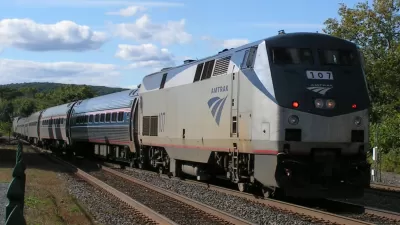Amtrak officials say they need $4.9 billion in funding to prevent service and job losses.

David Shepardson reports for Reuters on the financial state of Amtrak, where officials are asking Congress for $4.9 billion in additional funding to make ends meet during the pandemic.
Amtrak Chief Executive William Flynn went before Congress earlier this month to to request the additional funding, warning that the intercity rail system could face service and job cuts without the funding. Amtrak typically receives $2 billion in funding support from the U.S. government, according to Shepardson.
An earlier article by Pranshu Verma, written for The New York Times, also digs deeper into the pandemic context for Amtrak, comparing it to the U.S. Postal Service as a service provided by the government.
"For Amtrak, the coronavirus pandemic has not only slashed ridership and any chances of breaking even, it has also forced its leaders to face an existential choice: act like a for-profit airline or a government-subsidized entity," writes Verma.
Verma also provides more details on the specifics of the financial challenges facing Amtrak since the outbreak of the novel coronavirus earlier this year: "Since March, ridership on the national rail agency has fallen by 95 percent and projected revenue for 2021 has declined by 50 percent."
As noted in booth articles, Congress has already sent $1 billion in emergency funds to Amtrak, but Amtrak has been asking for more assistance since May.
FULL STORY: Amtrak CEO says passenger railroad needs up to $4.9 billion in U.S. funding

Alabama: Trump Terminates Settlements for Black Communities Harmed By Raw Sewage
Trump deemed the landmark civil rights agreement “illegal DEI and environmental justice policy.”

Planetizen Federal Action Tracker
A weekly monitor of how Trump’s orders and actions are impacting planners and planning in America.

The 120 Year Old Tiny Home Villages That Sheltered San Francisco’s Earthquake Refugees
More than a century ago, San Francisco mobilized to house thousands of residents displaced by the 1906 earthquake. Could their strategy offer a model for the present?

In Both Crashes and Crime, Public Transportation is Far Safer than Driving
Contrary to popular assumptions, public transportation has far lower crash and crime rates than automobile travel. For safer communities, improve and encourage transit travel.

Report: Zoning Reforms Should Complement Nashville’s Ambitious Transit Plan
Without reform, restrictive zoning codes will limit the impact of the city’s planned transit expansion and could exclude some of the residents who depend on transit the most.

Judge Orders Release of Frozen IRA, IIJA Funding
The decision is a victory for environmental groups who charged that freezing funds for critical infrastructure and disaster response programs caused “real and irreparable harm” to communities.
Urban Design for Planners 1: Software Tools
This six-course series explores essential urban design concepts using open source software and equips planners with the tools they need to participate fully in the urban design process.
Planning for Universal Design
Learn the tools for implementing Universal Design in planning regulations.
Clanton & Associates, Inc.
Jessamine County Fiscal Court
Institute for Housing and Urban Development Studies (IHS)
City of Grandview
Harvard GSD Executive Education
Toledo-Lucas County Plan Commissions
Salt Lake City
NYU Wagner Graduate School of Public Service





























